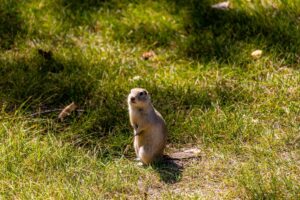Gophers and ground squirrels look similar but behave quite differently. However, both can damage your lawn or vegetable crops, so knowing what type of rodent is digging up your property is crucial to controlling their populations. Here’s how to know if you have a gopher or ground squirrel problem and what to do about it.
Gophers
A common gopher in Western Canada is the northern pocket gopher. Pocket gophers have small ears and eyes and a thick body and neck. They also have a nearly naked tail that helps them navigate backwards through their tunnels.
Pocket gophers have large pouches in their cheeks lined with fur, which they use to carry food through their underground tunnels. They can dig tunnels two metres deep, covering as much as 185 square metres. They spend most of their lives in their burrows and are active at any time of day or night all year long.
Richardson’s ground squirrels
Often confused with gophers, Richardson’s ground squirrels (RGS) are a type of squirrel that doesn’t live in trees but in tunnels. The RGS is much larger than a pocket gopher and doesn’t have any distinguishing markings. They’re active during the day, eating grasses and plants when available, and will store seeds and grains underground. They will hibernate over the winter.
How do you distinguish gophers from ground squirrels?
If you can’t see the animals, look at the entrances to their burrows. The entrance to a northern pocket gopher burrow is crescent-shaped and covered with dirt — and there’s no hole. RGS tunnels have open, round entrances about 13 centimetres in diameter.
Controlling gophers and ground squirrels
There are four ways to control gophers and ground squirrels:
- Rodenticides are effective in non-residential areas. Poisoned bait is placed directly into the burrow, and the hole or mound is covered with soil to reducing the chances of secondary poisoning of pets and other species. Rodenticides are rarely labelled for domestic use and should only be used by persons certified for pest control.
- Trapping is a method that traps the animal inside a hole. You need to inspect the tunnels frequently to check for trapped animals. No-kill traps aren’t recommended because of relocation laws, as many provinces ban wildlife relocation.
- Aspyxiation can be used if burrows are at least five metres away from any foundation or building. A product called Giant Destroyer looks like a piece of dynamite. You light the wick, place it into the hole, and then cover it with dirt. The device releases sulphurous gases into the burrow, killing the rodents.
- Shooting can also be effective for removing rodents, but only where it’s lawful.
Rodent control in Alberta, Saskatchewan and Manitoba
At Poulin’s Pest Control, our pest management professionals identify rodents and have knowledge, products, and equipment to safely eliminate your infestation. We provide effective pest control to residential and commercial clients across Alberta, Saskatchewan, and Manitoba. Contact us today to schedule a visit.

